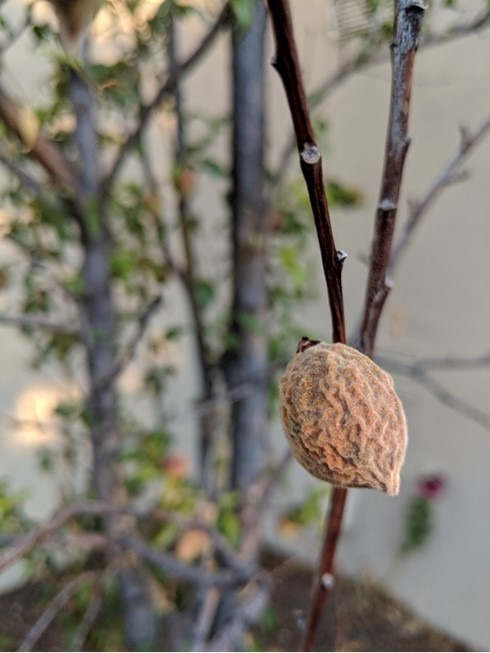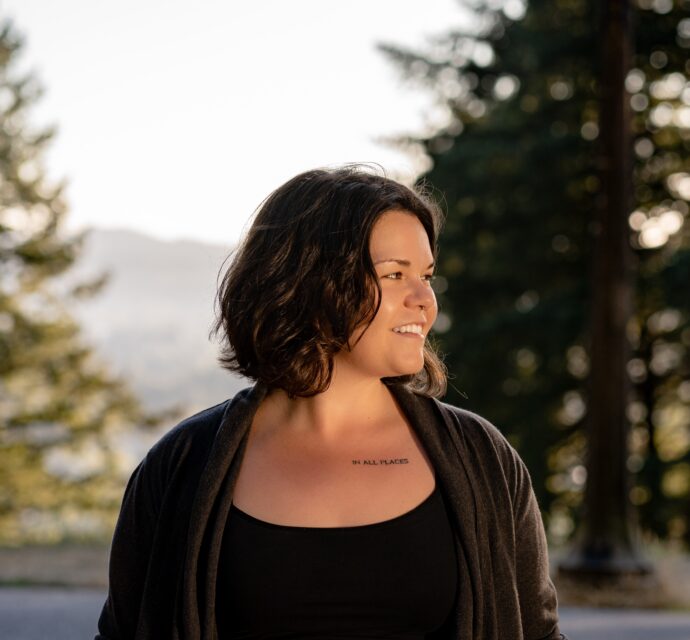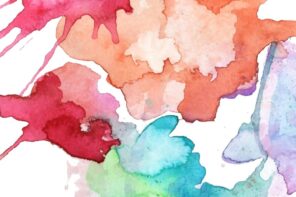A boy in the desert painted my picture once. He was living in a tent. There was snow on the ground, but he’d taken on a year of intentional homelessness—an artist thing. Or something. Although I look nothing like it today, the portrait hangs in my mother’s bedroom, composed after an old, thin photograph of mine: sharp jaw, prominent clavicle, lips flattened somber. He’d asked me if he could, and thanked me for letting him. He splashed watercolor mandalas over my heart and my eyes.
We’d met like you do these days—on the apps—and then at my favorite coffee shop in town. He was one of the dozen or so dates I took there over the year I lived in Santa Fe. I began to wonder if the baristas noticed, if they overheard my well-worn first-date stories and jokes. I began to wonder what they thought of me and my patrol of once-or-twice men, attempts I punctuated with solo visits: long hours spent at the long, wooden bar by myself; typing, asking for refills on my black coffee, carefully avoiding the pastry case. Wanting, so badly, to be looked at; glaring back at whoever was bold enough to look.
I was always afraid for them to see me. The boys, I mean. I was sure they’d suddenly understand I was not what I seemed. Ahead of those dates, I’d station myself in front of my full-length mirror to pull on black leggings or a sundress. I’d watch the chimera of my body disappear into my clothes: Rigorously thin, but bearing the history of its once-upon-a-time weight. My skin was pooled and stretchy, slouching around my thighs and stomach. I was a size four. I was gorgeous—or at least often told I was. I was, by my own reckoning, a fraud. So I foisted myself on those men. I begged them for proof.
In Santa Fe, I’d go home under too-bright moonlight, spin in my gravel driveway under a scrawl of stars. It was the first place I saw the milky way, that desert. Everything shut down so wholly and early; everything so hard, sharp-edged—until you looked closer. Another boy, a local who followed me up a mountain instead of joining me for coffee—anything but a meal—said he loved how you could think of any color you wanted, pick up a fistful of desert dirt, and find it there in your palm. He wrapped us sweat-soaked in a rough-woven throw blanket as we watched the sunset from Mount Atalaya, the town’s twinkling lights reified by all that wide-open space around them. We marched downhill in a shimmery darkness lit by the glowing galaxy above. When he told me he didn’t want to see me again, I was sure it was because I was too big.
I did not mean to wind up there. It was a series of coincidences that called me southwest: at the big writers’ conference in March, in Florida, a poet invited me to a workshop in Taos in July. I’d already planned to leave the mud-sunk RV in my parents’ backyard, where I’d been living for a few months between travels, by April—to start with wildflowers in the Smoky Mountains and let the road unwind from there. Now, I had a rough destination; I carefully aimed my loping trajectory. I didn’t know that once I arrived, I would stay.
I didn’t know it would be that desert’s deception, its unexpectedly frigid winters, that would do it—that would break the spell of my starvation after seven years. In Santa Fe, I decided to eat again—though the decision part happened later. It’d be much later, still, before I’d even consider the word anorexia. I’d never gotten small enough, I thought, to use that hex’s name.
The day after I signed the lease was the first monsoon of the season—the first rain they’d had all year, I was told. The mood in town was celebratory and cautious in equal measure: rain in the desert is thirsted for and revered. It is dangerous in its power. I curled on the couch of the sublet where I was staying to witness the storm through the windows. The stylish, gray sectional complemented the eclectic décor: in the living room, an African mask and a giclee of the Great Wave kept watch over wood furniture painted in motley; in the bedroom, a topographical map of Shiprock hung framed in minimalist grayscale. The owners, a married couple who both taught at a local college, had flown to India for six weeks to visit family. The monsoon blew the backyard wind chimes into a tangle, turning the wicker furniture upside down.
After the downpour, I drove slowly from the sublet to my freshly signed casita, emergencies flashing, avoiding the cars pulled off to the side of the flooded roads. When I unlocked the door—the keys hot in my hand, a risk and a novelty—I found the sideways rain had seeped in over the threshold, an inch of water washing the clay tile flooring. Luckily I hadn’t moved in yet. My landlord insisted it had never happened before, and to his credit, I never saw it after. But as long as I lived there, storms worried me—though more often than not, they missed us, drifting by like omens, visible and threatening, across dozens of miles of New Mexico sky.
Signing the lease scared me, too, but I didn’t know what else to do. I’d spent the better part of two years on the road at that point, perpetually alone, calling myself a nomad but mostly feeling lost—like I’d fallen between the cracks. A month before, I’d pawed at the window of my hostel room in Missoula, feeling in that town—and every—like oil in water. I’d already walked fruitlessly down and then back up the main drag thrice by then: silently perusing art galleries, conspicuously sipping café coffee. Parading around my pared-down body, thinking it would make me belong; realizing, instead, I’d disappeared.
When I arrived in Santa Fe, I found what the sublet’s hosts had left for me: a notebook and a bar of fancy soap—welcome gifts I could, because they were inedible, actually use. They’d outfitted a spare room with a squat rack and their mattress lay fashionably on the polished concrete floor. They asked me if I’d spray the glass doors with ylang-ylang-scented cleanser each time I showered. After months of hopping from one Airbnb to the next, it was almost pornographic: their library ranging from A Brief History of Time to The Cambridge Companion to Wittgenstein to Braiding Sweetgrass; the hulking shampoo and conditioner bottles in the neat little tile alcove, the type you pump instead of squeeze.
So, I let myself start looking. Just for fun, I said. When I found the casita three walking minutes from the Railyard, where the weekly Saturday market was held—the market where I’d sat in awe of a teenage boy playing a rolling piano, the market where I’d bought a handful of fresh-cut flowers in lieu of the fresh cherries and peaches and plums that gleamed like dangerous jewels—I held my breath. I stood in the empty bathroom with my hands on the counter; its odd maroon color, the drooping trumpet flowers painted onto the tiles lining the wall.
Could I? Could I do this? What if my freelance work dried up? I knew precisely no one in town. The Southwest, I knew from flying over it, was the great, exposed muscle of America, rippling red and endless, a sprawling space I always forgot meant one more hour’s time change. But I was so tired of running—so tired of the blur of motion it took to disappear myself. That’s why I told myself I stayed.
I don’t know if I realized then how well the landscape matched me—or more accurately, how well I matched it. A well-kept secret: Santa Fe is not technically in a desert, but rather a semi-arid steppe—with cold winters, as the Köppen Climate Classification System specifies. But true desert isn’t far. The Chihuahuan, Sonoran, Mojave and Great Basin deserts circle Santa Fe like a campfire, and the spirit of northern New Mexico is the same. It is a crying-out place, one whose apparent patience belies so much frenetic energy, so much fevered need. From 30,000 feet, you can see the action of its wanting: the riverbeds reaching, slim fingers gripping in and in on the land, and everywhere the water touches a slender margin of green.
Writing these words today—with five years and more than a thousand miles of distance, breathing the moist air of the Pacific Northwest, where green is abundant and inescapable as a hallucination—I look back on the photographs I took there: the edges of blue sky against clay-colored buildings; the subtle purple of distant mountains seen from the summit of a hike. None of them capture the reality of its extremes: Hot or Cold or Dry or Wet. Everything the place does, it does in capital letters. The desert’s richness and variety are offered only to those patient enough to wait out its monotony, careful enough to really look. It’s fair to say I fell in love with it; I travel back often, often consider splitting my time. But as is sometimes true of falling in love, the moment didn’t present itself with a sweeping, unmistakable gesture. It was more like: what else could I do? Where else could I be?
It is a kind of homesickness, to look at those pictures—of the landscape and of myself, the endless, anxious selfies that mark this time in my life in my phone’s photo history, like a stratum of sediment. I was so lonesome, and sick in a way I couldn’t then classify—but in hindsight, there’s a romance. It’s not the one I wish it were: that this was the place where I’d let the tender slip of my body come back again, let myself finally expand. In fact, it’s the opposite. I’m nostalgic for Santa Fe because it’s where she lives in perpetuity, that agave stalk of a girl. If I could have kept it up, if I could have kept her: slender and beautiful and not too cold to live, a girl who never runs away, who spins under the freezing stars forever.
But she was not to be.
It started with the apricots—so many they smashed on the sidewalks, their abundance too much for the ubiquitous trees. Those trees were everywhere in town, lining the picturesque plaza and unlovely industrial alleyways alike. I remember the first time I plucked and ate one, a perfect little package of golden-orange sunshine suspended over a suburban street corner, haloed in blue. Its sweetness flooded me, felt impossible. I pulled out my phone to Google it: seventeen calories, three grams of sugar. Surreptitiously, unbelieving, I plucked and devoured two more, their flesh July-warm and juicy.
Later I saw, on a tree in front of the sublet, an apricot, seed strung naked on its branch. The bare stone hung perfect, unlikely, and raisin-like at the end of its twig. I wondered if this was how they grew, from the inside out, slowly filling out with the flesh of fruit. It isn’t—they start out small and green as olives; these naked pits were more likely the product of scavenging birds and squirrels. But I couldn’t shake the illusion, though I did not yet see the metaphor for myself.
Then, the fruit trees at my casita: two plums in the front yard, one whose fruit was sweet, one bitter, both of which wound up smeared across my terracotta tiles, transported in the tread of my boots. In my backyard stood a squat and sturdy apple tree that put out dozens of small, firm fruit—not quite crabapples, but minute enough to fold into your hand. As fall fell, I pulled their little green bodies from its branches for days on end, let them spill from the oversized bowl onto the tiled counter. The wet crunch of their bite felt like a revelation. Maybe, I thought, I could allow myself this small source of sweetness—so immediate. So whole.
And then came the winter.
I’d taken, over the years, to stashing my most palatable foods in my car, hoping the trek down my driveway would prove effort-intensive and public enough to disincentivize me. That year, I kept in my trunk two boxes of a cult-following brand of low-carb protein bars whose first three ingredients were whey protein, soluble corn fiber, and water. Sitting in my house as evening fell, I fantasized about them: the soft way they gave in to the pressure of teeth, the muted crackle of “chocolatey” chips or gummy white coating. They had seasonal flavors. That winter, I hoarded Peppermint Bark: 190 calories, 7 grams of fat, 21 grams of protein. Subtract the fiber (14g) and erythritol (4g) from the total carbohydrate (22g) to get 4 grams of net carbs—less than a serving of baby carrots.
The snow-globe season offered another layer of deterrent: the cold. I curled in the well of my papasan reading chair as the evening fell, alone—as usual—and swathed in silence. I faced the vital but temperamental gas heater, regarding it like a tiny god. I got up and checked on the black widow spider who lived behind it, making a life between the warmth and the wall; I’d named her Virginia Woolf, though we shared the room. Half an hour before sleep, I scampered downstairs to my half-basement bedroom to turn on the heated mattress pad. As had been my habit for years by then, I planned to go to bed hungry—to wake up feeling empty and clean.
But my hunger had grown stronger than my plans—had, after almost a decade, become an autonomous being. Pulling on my faux-fur-lined boots and tromping through the midnight snow was in no sense a decision. Back inside, I stripped off my heavy coat and let it fall to the floor, still in pajamas beneath it. I ripped through the wrappers and tossed them in the sink. I crouched in front of the grimy oven window to watch their plasticine vanilla coats soften in the red-enameled, cast-iron pan my mother had sent with me when I’d left Florida. The protein bars had frozen solid outside in the cold.
The ground was frozen, too—but I pulled my body up mountains, winter be damned. How else to burn off those late-night transgressions? For a fourteen-mile uphill hike, I packed absolutely nothing edible. I took a single liter of water and a size-small fleece that swallowed me whole. I told myself I’d eat when I got home, if I had to.
I had to. I had to. Thwarted halfway by snow past my ankles—the yellow leaves of fallen aspen floating on the new, white sea—I drove myself back down the ski bowl, defeated. Delirious, as if in a fugue state, I hoisted myself up onto the kitchen counter, tore open the cabinets. I took down a can of unsweetened coconut cream and sunk my can opener into it; inside, a solidified white crust crumbled over clear, viscous liquid. I spooned the flavorless mess into my mouth undifferentiated, unbothered; I followed it with fistfuls of raw cashews from an ancient bag.
I consumed two thousand calories in the space of ten minutes. I couldn’t help it. After almost a decade of restriction, I was breaking down.
And what if I did? What if, after all these lean and bloodless years, I expanded?
But I was beautiful enough to draw, and that artist boy wasn’t the only one who thought so: my landlord in his truck in the driveway, brake lights lit, saying he always stopped to let pretty girls go by; the guy in the gym, six feet tall and caramel brown, who came over unbidden to help me track my rep count, standing between my legs and catching my elbows as I crunched myself up and up on the decline bench. And the doctors who, despite my years-absent period, despite my stress fractures and chills and falling-out hair, commended me for the massive weight loss that had so obviously been a healthy, empowering, and tough-love action. Of course it could not be anorexia: that condition marked by visible breast bones and ample thigh gaps, the skeletal shape starved for by girls who’d started with the body I’d always wished to have. Even then, after so much starving of my own, I did not; my body held onto its dense pack of muscle, my thighs meaty and strong. No medical professional I saw so much as cocked a concerned eyebrow, even when multiple blood tests showed my estrogen levels were post-menopausal.
So I stuffed myself into the tight cave of my “normal-weight” body, that shining shell I’d whittled and honed. I took my endless photos in the full-length mirror, naked or nearly, sucked in and posed. Not smiling. Always the eye of the cell phone camera winking at my reflection, always the flashily painted wardrobe behind me, a panopticon of tiny clothes. Sunken eight feet into the ground, the ceiling beams broken by a skylight, the room felt like a ship’s hold. I was afloat.
The casita shared a single wall with a neighboring unit, and some nights, I could hear them: a beautiful couple, a man and a woman. They were both thin—effortlessly so, or at least it seemed to me—as well as light-haired and lovely. Either could have been an Abercrombie model. They were a year or two younger than I was, but had been together for half a decade; they’d met in college before they’d both shipped off to separate Ivies for grad school. They were in Santa Fe because he’d found a job there—though she admitted to me once, standing in the open gateway of their towering privacy fence, that they hoped they’d one day be able to move to a bigger city. Toward the end of that summer, when the nights were growing pleasantly cool, I heard them playing Frank Sinatra while they assembled their dinner: pasta, with tomatoes they’d grown in their garden for a fresh, simple sauce.
“It’s so gorgeous! Let’s eat outside,” she said, her voice warping through the wall as she moved from their kitchen into their enclosed front courtyard.
“Al fresco!” she chirped, their new puppy barking joyfully at her feet.
I sat inside with my raw broccoli and vinegar, avoiding the holes in their privacy fence as I schlepped my laundry to our shared machine. I hated them.
One night, they invited me over. For dinner. So I could make a show of eating something, I assembled a salad, shook up a tiny jar of homemade dressing on the side. When I arrived, there were already other guests I hadn’t known about, had never met before. I deflated. I felt enormous as their wrought-iron patio furniture pressed waffle print into my thighs.
It was painstaking, eating with others—being with others at all. I’d grown so used to being alone by then, my house was outfitted for it: my stark dining table with its four chairs, three extraneous; one little reading nook and no couch. One of the men I brought home—my carefully carved exception to the rule, a transactional connection whose calculation I understood—called it a “fortress of solitude.” Another made fun of the design’s lack of romantic nuance: we were either sitting straight-backed at the dining room table or heading to bed.
At the party, I sat quietly between the neighbors I barely knew and their friends, who I knew not at all. I don’t remember what I said, but I felt sure I was failing the conversation. I politely refused the offer of cheese on my burger; I asked for a fork so I wouldn’t have to bite into the bun. I apologized stiffly and tried to legitimize myself: I was paleo, I had a sensitive gut, I didn’t get along with dairy. They smilingly accommodated me; they waved away my apologies.
I watched the people around me happily mow through bruschetta on fat slabs of fresh toast topped with feta, pick up their burgers in a perfect hand-hold, carbs and all. I sank into my body—my body, my body, this center, this sinkhole. All this effort I made—and all these people around me, living their lives, feeding themselves, chattering to each other. Their bodies were sturdy and fit and seemingly irrelevant. I was shocked and confused. I felt I’d missed some part of the algebra.
After that night, we maintained a nodding acquaintanceship, but my neighbors never invited me back for dinner again. I don’t blame them. Even if they had, I couldn’t possibly have returned, ensconced and sour as I was. Imprisoned.
On a recent return trip to Santa Fe, I sent the woman-neighbor a message—the first correspondence we’d had in almost four years. Last-minute and a stretch, I write, and no pressure regardless, but I’m in Santa thru Sunday if you two wanted to grab a drink or a bite. I actually eat now, lol.
Her response comes a day later, including many exclamation points and explaining that they’re abroad on vacation—and besides, they’ve recently moved to Lake Tahoe. (So much for the big city.) Love that you’re there, she says. Makes me homesick! Hope you’re having a blast! When I text back that, among other things, I’d hoped to apologize for being kind of a grumpy, terrible neighbor, lol—I was going through some shit—she responds that she’s glad we’re still in touch before marking my message with a tiny emoji heart. I read it while eating the end of a fresh baguette from the French bakery I’d never, when I lived here, allowed myself to visit.
That spring had offered slow, then sudden clarity, like the sunrise revealing a canyon to cross. When I could see where the trajectory was leading—that the 10 pounds of “winter weight” the cold had pulled onto me were just the start—I ran away one more time. I couldn’t stand the prospect of expanding in front of the few people in Santa Fe I’d tried to shoehorn myself into community with. That project had been impossible precisely because I was afraid for them to really see me—and especially to see the broadening of my body I could still only read as failure. I didn’t know then what was happening to me wasn’t failure, but survival.
Before I left, I looked at myself again in that mirror—the one in which I’d twisted and turned my body to scrutinize every angle, the one in which I’d decided, ten months earlier, to stay. The angles of my face had already begun their softening, the flesh around my smile filling in. I don’t know what’s about to happen, I said to myself—to my body, my poor body, my intimate enemy, my home. But whatever happens, I will never starve you again.
It would take more than a year before I’d make good on that promise, before I’d regularly eat bread—and apricots, and cherries. More than a year before I’d walk home from a weekend farmers market laden with fresh milk and stone fruit, before I’d let myself eat those goods in solace and companionship alike. Longer still before I’d ask my own partner if we should dine al fresco on the black beans and sweet potatoes and beets he’d cooked for us, a homely, wholesome plate of long-forbidden starch; before I’d let myself feel the full weight of love and acceptance and desire—the kind that has nothing to do with visible collarbones.
It would take time, and another season of travel, another tearing up of roots. It would take an outgrowing: of silence, of starving, of secrets; of every square inch of my clothing, the arsenal I’d been building since I’d first started to shrink. Those tiny scraps, doll clothes, that had always been too small. It would take leaving behind the desert and arriving in the Pacific Northwest’s forests, allowing their abundance; eating a proffered slice of Pike Place peach, letting its juice run off my chin.

Jamie Cattanach is a Florida-born writer based in Portland, Oregon—though a shard of her heart will always live in the desert. Her words have been featured or are forthcoming in Fourth Genre, Nashville Review, DMQ Review, Thin Air Magazine, SELF, Ms. Magazine, and many other outlets. She’s an Assistant Editor for the essays column at The Rumpus, and her in-progress memoir — from which this essay is excerpted — was chosen for the 2022 Tin House winter workshop manuscript mentorship program. Find out more at www.jamiecattanach.com.




